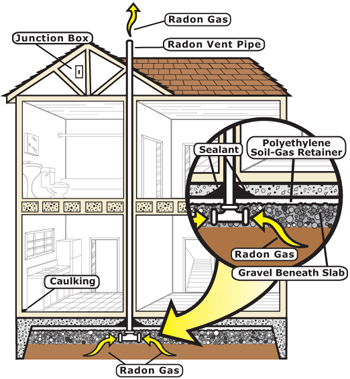
Go Green - Build Green - Stop Radon!
You can’t live in a Green home with radon. Insist on having a passive radon system installed in your new home during construction. Radon systems will vent gases, chemicals, mold and moisture safely out of your home before you have a chance to breathe them in! It’s cheap, easy and for the entire life of the structure, your radon system will provide you and your family with a healthy home.
Basic Techniques for Radon-Resistant New Construction
All of the techniques and materials described below are commonly used in home construction. No special skills or materials are required when adding radon-resistant features as a new home is being built. New homebuyers should ask the builder about these features, and if not provided, ask the builder to include them in your new home.
While techniques vary for different house foundations and site requirements, the five basic features that builders should include to prevent radon from entering a home are:
Gravel: Use a 4-inch layer of clean, coarse gravel below the basement floor also called the "slab". This layer of gravel allows the soil gases, including radon to move more freely underneath the house.
Plastic Sheeting or Vapor Retarder: Place plastic sheeting (6 mil. or greater polyethylene) on top of the gravel. The sheeting keeps the concrete from clogging the gravel layer when the slab is poured.

Vent Pipe: Run a 3-inch or 4-inch solid PVC Schedule 40 pipe vertically from the gravel layer (stubbed upbefore the slab is poured) through the house’s conditioned space up and out through the roof to safely vent radon and other soil gases outside above the house. If your home is being built with drainage tile or form-a drain below the slab, join the radon pipe to the drainage tile system below the slab. Your plumber or a certified radon professional can do all of this. Try to keep the radon pipe as vertical as possible. If you must run part of the system horizontally, make sure the pipe is pitched back towards the slab and do not allow for any bends that could allow water within the system to accumulate. Once installed, label all visible pipe, "Radon System."
Sealing and Caulking: Seal all openings, cracks, and crevices in the concrete foundation floor (including the slab perimeter crack) and walls with polyurethane caulk to prevent radon and other soil gases from entering the home.
Junction Box: Install an electrical outlet near the vent pipe in the attic in case a radon removal fan is needed.
After you move in, test the home. If radon levels are still high, hire a radon specialist to inspect the system and install a radon fan in the attic. Saves time, money and most of the system will be concealed.
Go Green - Stop Radon!
This site is made possible by visitors like you.
Thank you and we appreciate your support!
